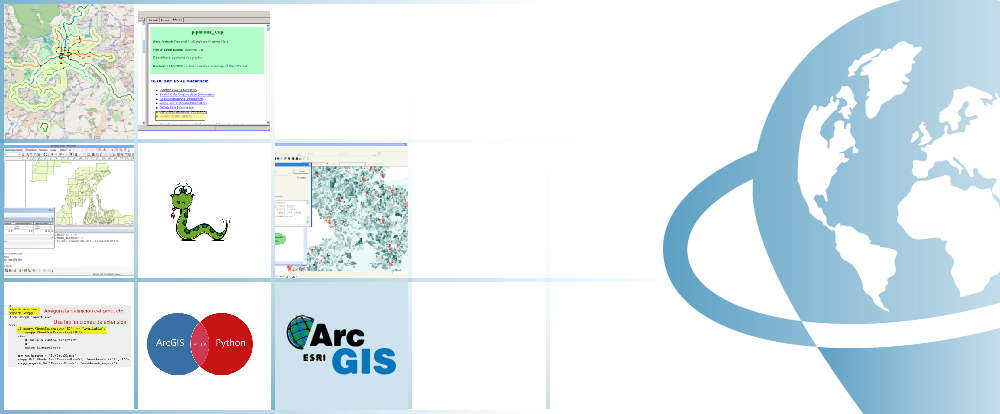USING PYTHON WITH ARCGIS (BEGINNER LEVEL)
ONLINE TRAINING
START DATE: AVAILABLE SOON (80 hours)
PRICE: 250 € (Standard fee) | 225 € (Student / Unemployed fee)

The course is focused on the initiation of students in the use of Python programming language along with ArcGIS Desktop collection software on: process and tasks automation, vector and raster analysis, map generation and publication, geoprocessing model creation, etc.
The purpose of this course is to transmit to the student information about creating and editing spatial data using Python programming language, a command line software application which can be directly applied when creating complex stand-alone Python scripts or Python script tools. Use Python to power up your GIS needs, automate your workflows and take advantages of all ArcGIS platform capabilities.
Enrolled students in this online course will have access to our virtual e-learning platform (which is available 24 hours), where they will find the content of the course, practical exercises, forum discussion and additional content. One of the advantages of this online platform, is that students can benefit of real time support and assistance offered by the instructor (2 hours per week), whom they can contact via direct messages, regarding course related issues, at any moment. They can also contact the instructor via email.
- Understand what programming is and how can be used to solve certain spatial problems, how Python programming language can be used along with ArcGIS platform capabilities.
- Provide training in the automation of tasks and development of scripting tools using Python programming language in ArcGIS environment.
- Improve your GIS skills and familiarize yourself with a programming and scripting language. Gain knowledge in GIS development environment.
1 - FIRST STEPS WITH PYTHON AND ARCGIS
- Create a Python script file
- Comments
- Variables and types
- Strings
- Numbers
- Lists
- Dictionaries
- Statements
- Python – Decision Making – if statements
- Loop Statements
- Python File I/O – Read and Write Files in Python
- Modules
2 - PYTHON PROGRAMMING LANGUAGE
- The geoprocessing framework in ArcGIS
- What is Python?
- Introducing Python using the Python window in ArcGIS
- Python Development Environment
- Integrate Python in the Geoprocessing environment
3 - WHAT IS ARCPY?
- Introduction to ArcPy
- Data access module – arcpy.da
- Accessing geoprocessing tools
- ArcPy Features
- ArcPy Classes
- ArcPy Modules
- Importing ArcPy
- Python and ArcPy versions
4 - ENVIRONMENT CONFIGURATION
- Getting and setting environment settings
- Most used configurations/settings
- Environment settings
– Environment levels and hierarchy
– Switch from application to tool
– Scripts - Env” class
5 - ARCGIS GEOPROCESSING SERVICES AND TOOLS IN PYTHON
- Introduction to Geoprocessing tools
- Toolbox names, labels and alias
- Understanding tool syntax
- How to use Geoprocessing tools
– Tool examples
– Buffer
– Append - Help
- How to Create a Custom Tools
- Exploring and working with toolboxes
6 - ERROR HANDLING
- Error messages
– Understanding message types and severity
– Receive and Respond to a Text Message with Python - Result Objects
- Python – Exceptions Handling and how to manage them
– Python exception message capturing
– Event notification system
– Handling special cases - Exploring the default Python error message
– try statement
– try/except/else
– try/finally
– raise
7 - INTRODUCTION TO ARCPY.MAPPING
- What is arcpy.mapping?
- Using arcpy.mapping to control map documents and layer objects
– Getting a list of layers in a map document
– DataFrame
– Fixing Data Sources
– ListTableViews
– ListLayoutElements
– Adding, Working and updating layers in a map document - Printing or exporting maps
– Export and print map documents to PDF using Python - Publishing a map service to ArcGIS Server
– Use the arcpy.mapping function AnalyzeForSD to analyze your draft service
– Converts a map to a map service definition (.msd) file
– PublishMSDToServer
8 - CREATE LISTS OF DATA
- Introduction
- List of ArcPy functions
- Field
- Index
9 - HOW TO OBTAIN DESCRIPTIVE INFORMATION ABOUT DATA
- Describe function – ArcPy Functions
- FeatureClass properties – ArcPy Functions
- Get Raster Properties
- Get Layer properties
- Table properties – ArcPy Functions
- Dataset properties
- Workspace properties
10 - USE GEOPROCESSING TO SELECT, EDIT AND ADD DATA TO EXISTING TABLES AND LAYERS
- Introduction
- Cursor object functions
– InsertCursor
– SearchCursor
– UpdateCursor - Geometry Objects
11 - OTHER ARCPY ELEMENTS
- SpatialReference
- Extend
- FieldMappings, FieldInfo, FieldMap
- Point, Polyline, Polygon
- Array
12 - ACCESSING LICENSES AND EXTENSIONS
- Introduction
- Licenses for ArcGIS products: Desktop, Engine, Server
- Extension Licensing
13 - GEOPROCESSING REPORTS
- Using geoprocessing options to control tool execution
- Viewing script tools execution history
- Using the Results window
- History log files
- Viewing metadata


Alberto Santos Estévez
Consultant and Geospatial Developer with more than 15 years’ experience in GIS integrated solutions and high performance systems.
Chencho Martín Lagunas
GIS Developer with extensive experience in Full-Stack software development, specialized in GIS data analysis and pre-processing using Python.
Why should we learn Python programming language and Geographical Informational Systems?
Geographic Informational Systems (GIS) are rapidly spreading and becoming an essential tool in many work fields including, engineering, environment, geography, geology and mining, emerging sciences, geomarketing. Programming in the GIS software environment became a essential skill and a critical requirement for most geospatial jobs opportunities. Nowadays, the majority of GIS jobs require some programming capabilities or application development.
Our online courses, are distributed via Moodle, the world’s most popular learning platform. It is a highly flexible Learning Management System that can be used to conduct and access courses, accomplish tasks of practical exercises, interact face-to-face to the teaching staff or benefit of support and resources at any time.
The online platform can be accessed 24 hours a day, in which the student will be able to ask for help at any given moment. The instructors will act as supervisors during all the training process, offering support for any possible difficulty encountered by the students along the course.
The course is structured in different modules, making it easy for the student to search for training material, download information, complete practical exercises and take assessments in order to verify their new gained abilities. The instructors will assist the students throughout all the course period, offering progressive help and information according to their evolution.
250 € (Standard fee) / 225 € (Student / Unemployed fee)*
*To enjoy this discount, you must include a copy of a document that proves your situation along with the registration form.
** If you want to know the price in other currencies, you can consult the following online converter: The Money Converter

Step 1. Request your registration to the training course completing the pre-registration document (Registration Form) and send it via email to training@tycgis.com.

Step 2. As soon as we receive it, we will send you an enrolment guide with the complete information to enroll in the course: dates, schedule, software needed for the course and the installation guide. The payment methods are included in this document.

Step 4. Once we receive the receipt, we will confirm your registration to the course via email.

NATIONAL WIRE TRANSFERS (INSIDE SPAIN):
ACCOUNT NUMBER: 0049 1809 222710347481 (Banco Santander)
BENEFICIARY: TYC GIS Soluciones Integrales SL
SUBJECT: “Student Name” and ARCPY I COURSE ON
INTERNATIONAL WIRE TRANSFERS:
BANK NAME: Banco Santander
BANK ADDRESS: Glorieta Ruiz Jiménez 1, 28015 Madrid (España).
BENEFICIARY: TYC GIS Soluciones Integrales SL
BENEFICIARY ADDRESS: Calle Fuencarral 158, Entreplanta, Oficina 16-17 28010 Madrid (España).
ACCOUNT NUMBER: ES90 0049 1809 222710347481
SWIFHT: BSCHESMM – IBAN: ES90
If you have payment difficulties, contact us





 (19 votes, average: 4.84 de 5)
(19 votes, average: 4.84 de 5)


